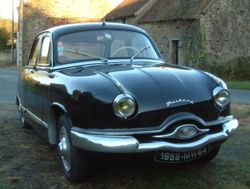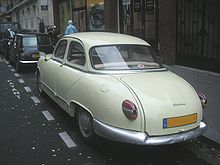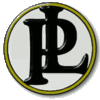Panhard Dyna Z
| Panhard | |
|---|---|
| Dyna Z | |
| Sales designation: | Dyna Z |
| Production period: | 1953-1960 |
| Class : | Middle class |
| Body versions : | Sedan , cabriolet , station wagon , pickup |
| Engines: |
Petrol engines : 0.85 liters (31–37 kW) |
| Length: | 4270-4580 mm |
| Width: | 1600-1720 mm |
| Height: | 1460-1645 mm |
| Wheelbase : | 2570-2800 mm |
| Empty weight : | 815 kg |
| Previous model | Dyna X |
| successor | PL 17 |
The Panhard Dyna Z was a middle class passenger car from the French manufacturer Panhard . Of the successor to the Dyna X model , 303,541 units were built between 1953 and 1960. The Panhard Dyna Z followed the model PL 17 .
Model development
The body of the Dyna Z, like that of its predecessor, was originally made of aluminum and had tubular steel subframes at the front and rear, which were connected by steel plate reinforcements in the sills. In the course of 1956, the aluminum sheets were gradually replaced by sheet steel. In 1958 only the bumpers, tank, cooling jacket of the engine and most of the engine and transmission parts were made of aluminum, but the overall weight of the car was still relatively low for a comfortable six-seater sedan.
Its modern design gave it a unique combination of good space, driving comfort, performance and economy at a moderate purchase price. However, the reliability left a lot to be desired, and the car also suffered from strong engine and wind noise. The Tiger version had a more powerful engine with a larger cooling jacket.
Models
| model | Construction period | Engine type | Displacement | Tax horsepower (fr.) | power |
|---|---|---|---|---|---|
| Z1 BL / BLS | 12/1953 - 05/1956 | 2-cylinder boxer 4-stroke | 851 cc | 5 CV | 42 hp (31 kW) |
| Z5 BL | 01/1956 - 07/1956 | 2-cylinder boxer 4-stroke | 851 cc | 5 CV | 42 hp (31 kW) |
| Z6 BLS | 04/1956 - 09/1956 | 2-cylinder boxer 4-stroke | 851 cc | 5 CV | 42 hp (31 kW) |
| Z11 BL taxi | 08/1956 - 07/1959 | 2-cylinder boxer 4-stroke | 851 cc | 5 CV | 42 hp (31 kW) |
| Z12 BLS / BGL | 08/1956 - 10/1958 | 2-cylinder boxer 4-stroke | 851 cc | 5 CV | 42 hp (31 kW) |
| Z16 BGL | 07/1958 - 09/1959 | 2-cylinder boxer 4-stroke | 851 cc | 5 CV | 42 hp (31 kW) |
| Z16 BGS Jaeger Tigre | 02/1959 - 07/1959 | 2-cylinder boxer 4-stroke | 851 cc | 5 CV | 50 HP (37 kW) |
| Z16 BGS Tigre | 07/1958 - 09/1959 | 2-cylinder boxer 4-stroke | 851 cc | 5 CV | 50 HP (37 kW) |
| Z17 CGS (Cabriolet) | 10/1958 - 04/1960 | 2-cylinder boxer 4-stroke | 851 cc | 5 CV | 42 hp (31 kW) |
| Z17 CGS Jaeger (Cabriolet) | 02/1959 - 04/1960 | 2-cylinder boxer 4-stroke | 851 cc | 5 CV | 42 hp (31 kW) |
| Z17 CGS Tigre (Cabriolet) | 03/1959 - 04/1960 | 2-cylinder boxer 4-stroke | 851 cc | 5 CV | 50 HP (37 kW) |
| Z18 BLS | 11/1958 - 01/1959 | 2-cylinder boxer 4-stroke | 851 cc | 5 CV | 42 hp (31 kW) |
| D65 (station wagon, pickup) | 10/1958 - 08/1959 | 2-cylinder boxer 4-stroke | 851 cc | 5 CV | 42 hp (31 kW) |
| F65 (station wagon, pickup) | 10/1958 - 08/1959 | 2-cylinder boxer 4-stroke | 851 cc | 5 CV | 42 hp (31 kW) |
Data for model Dyna Z Tigre (1958)
- Purchase price (in the USA ): 2000 US dollars (the price was on par with a lower mid-range car, between that of the Volkswagen Beetle and that of the Peugeot 403 ).
- Engine: two-cylinder four-stroke boxer engine with 851 cm³ displacement, air cooling; Valve springs as roller-bearing, concentric torsion bars; Valve lifters; Crankshaft and main bearings as roller bearings according to the "Panhard patent"; Sack cylinders with non-removable cylinder heads made of aluminum; dry cylinder liners; soft engine bearings that dampen the rough engine running of the two-cylinder; Radial fan at the end of the crankshaft; large cooling jacket made of aluminum with cooling fins.
- Output: 50 hp (37 kW) at 5500 rpm.
- Drive: front-wheel drive. The drive shafts are concentric tubes with rubber spacers, cardan joints on the differential and double cardan joints ( constant velocity joints ) on the wheel.
- Gearbox: 4-speed gearbox with cable control in a cast aluminum housing together with the differential gear; 2nd and 3rd gear synchronized; 2nd and 4th gear with herringbone teeth ; Steering wheel shift. Unlike most front-wheel drive cars with a longitudinally installed engine, the Panhard has the gearbox installed between the engine and differential. The engine, clutch, gearbox and differential gear are one behind the other. The direct drive (1: 1) is achieved via 3rd gear; 4th gear is designed as overdrive .
- Clutch: friction clutch with cable actuation. In some markets there was also a magnetic clutch that was filled with iron filings: when the coil attached to the housing is energized, these filings stiffen and connect the clutch basket attached to the crankshaft to the clutch disc on the transmission input shaft. The electrical energy is generated by a special double alternator, whereby one winding supplies the current for the battery and the rest of the electrical system and the other the current for the magnetic coupling. When the engine accelerates above idling speed, the clutch engages slowly.
- Empty weight: 815 kg
- Petrol consumption: approx. 6 l / 100 km
- Top speed: 144 km / h
- Steering: with auger, behind the front suspension, short steering column.
- Front suspension: two transverse leaf springs, bent downwards; large ground clearance. No stabilizer, which leads to lifting of the inside rear wheel in sharp corners. Steering levers and steering shafts rotate in sockets that are mounted in the eyes of the transverse leaf springs.
- Rear suspension: Rigid axle on drawn support levers that act on torsion bars. The axle is a V-shaped tube between the rear wheels, which is fastened in the middle with a rubber mount to the cross member of the rear subframe. On each side there are three parallel torsion bars that are connected to one another on the inside. As with the front axle, there is no stabilizer.
- Body: made of sheet steel (on earlier models: aluminum sheet), streamlined shape, four doors, low air resistance (C w value: 0.26) despite flat, non-frame-flush side windows, windshield and rear window with rubber seal and rain gutters.
- Interior: six seats on two bench seats
- Brakes: drum brakes in the wheels; low pedal force despite no brake booster; Brake drums made of aluminum with riveted steel braking surfaces (replaceable); later models with cooling fins.
Driving impressions
The aluminum tanks are often leaky on the level sensors. In sharp corners with an empty trunk, the car lifts the inside rear wheel like a Citroën 2CV despite the downward bending of the front transverse leaf springs. This was probably caused by the weight distribution and spring rates. The landing gear swallows large waves and holes. The driving stability is very good despite the sometimes raised rear wheel. The steering is very smooth, although there is no power assistance. The driver and front passenger slide around on the smooth plastic covers of the seat. The heating is very effective. To engage the 4th gear, a double clutch is required, but this is not a problem because the 3rd gear is designed as a direct gear. Reverse gear is hard to find. Due to the soft engine mounts, the clutch is difficult to use for inexperienced drivers. The brake lights also serve as reversing lights (since the ignition lock is bridged by the rear light unit, the car can be started without a key when reverse gear is engaged and the footbrake is on!). The car does not have a steering wheel lock, but the (in the USA) unusual controls make it relatively theft-proof. For additional security, the connection to the battery can be disconnected with a main switch (designated with a French abbreviation of two letters) on the steering column. As with modern vehicles of the 21st century, the indicators, the parking lights, the high beam and the two-tone horn are operated with the same lever. This makes all of these functions easy to find; however, the indicator can easily be mistaken for the high beam. A complicated lifting platform was required to lubricate the vehicle, which at the time was not available at most petrol stations. The vehicle is often cited as an example of an aerodynamic design. The crest stern was not common back then.
literature
- Votre Panhard Dyna elt PL 17, Tous les Modèles depuis 1954. 8 ° Édition, Édition Practique Automobiles, Paris, LIT .: 15-14.
- Panhard factory repair manuals and part book for Dyna 54 (aluminum cars), '56 -'60 Dyna , Les Archives du Collectioneur. EPA-Verlag, Dyna '54 etc., PL 17, 24.
- Benoit, Pérot: Panhard, la doyenne d'avant garde. EPA publishing house, Paris 1979.





